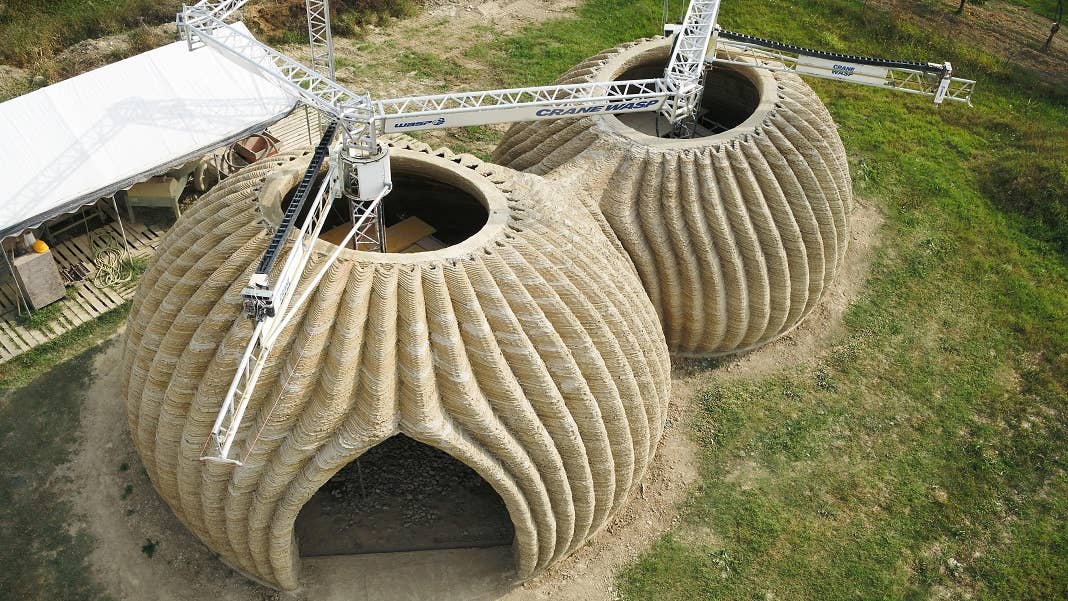This Hive-Like House Is 3D Printed, Carbon-Neutral, and Made of Clay

Share
3D printing homes was a really big deal a few years ago; the idea was novel, unprecedented, and crushed records for the cost and time it took to build a livable house. Now 3D printed homes, while not yet prosaic and still pretty wow-worthy, have certainly become more commonplace, with all sorts of variations: prototypes meant for Mars, two-story apartment buildings, entire communities; it seems there’s still plenty of space to play with the technology and plenty of innovation around new concepts to build with it.
One of those will soon be unveiled in northern Italy, and it boasts its own set of unique features to set it apart from its 3D printed predecessors. But calling it “futuristic” feels a little off, as some of those features seem like more of a throwback to the distant past, or an homage to nature and conservation.
The house goes by the acronym TECLA—short for “technology and clay”—which is appropriate given that this is what the structure is made of. It’s a collaboration between WASP, (which stands for World Advanced Savings Project), an Italian company that makes 3D printers, and Mario Cucinella Architects.
If you think it looks sort of like the giant nest or hive of some sort of winged insect, you’re spot-on; TECLA’s design is based on the hive of the potter wasp, a species of wasp found in the northern hemisphere that preys on caterpillars and whose hive is made of mud and shaped like a pot.
Living in a home based on that of an insect that might have stung you as a child and which you’d gladly squash with a rolled-up newspaper if given the opportunity might not be everyone’s cup of tea. But in its defense, TECLA does bring some impressive stats to the table.
For starters, as mentioned above, the house is built entirely from material taken from the local terrain. You’re probably thinking, ok, sure, I guess you can build a house from “local terrain” if that terrain happens to be durable, moldable, non-toxic clay, and you live in an area that’s not too hot, not too cold, and not too rainy.
Be Part of the Future
Sign up to receive top stories about groundbreaking technologies and visionary thinkers from SingularityHub.


But according to the project’s creators, the house and its source materials are “adaptable to any climate and context.” WASP is even selling what it calls a Maker Economy Starter Kit; it consists of four 3D printers and a system for picking, mixing, and pumping local materials to print with. The company hopes its technology will be used to facilitate housing projects in remote areas.
Unlike other projects that use one printer on rails, this structure employs two printers working simultaneously. Printing a TECLA house takes 200 hours and uses 7,000 computer codes. The printed layers are 12 millimeters thick, and you need 350 of them total. The volume of “natural materials” required is listed as 60 cubic meters, and the energy consumed in the building process is a mere 6 kilowatts.
Though it seems like a concept that wouldn't have a multitude of variations, this actually isn't WASP's first 3D printed, natural-materials-based house; the company built a house it called Gaia back in 2018, this one made primarily with waste material from the rice production chain.
The printing phase of the TECLA house was completed last month, and after finishing touches are added and some publicity buzz generated (pun intended), the project is scheduled to be presented to the public this spring.
Image Credit: WASP
Vanessa has been writing about science and technology for eight years and was senior editor at SingularityHub. She's interested in biotechnology and genetic engineering, the nitty-gritty of the renewable energy transition, the roles technology and science play in geopolitics and international development, and countless other topics.
Related Articles

This Light-Powered AI Chip Is 100x Faster Than a Top Nvidia GPU

This Week’s Awesome Tech Stories From Around the Web (Through December 20)

Data Centers in Space: Will 2027 Really Be the Year AI Goes to Orbit?
What we’re reading